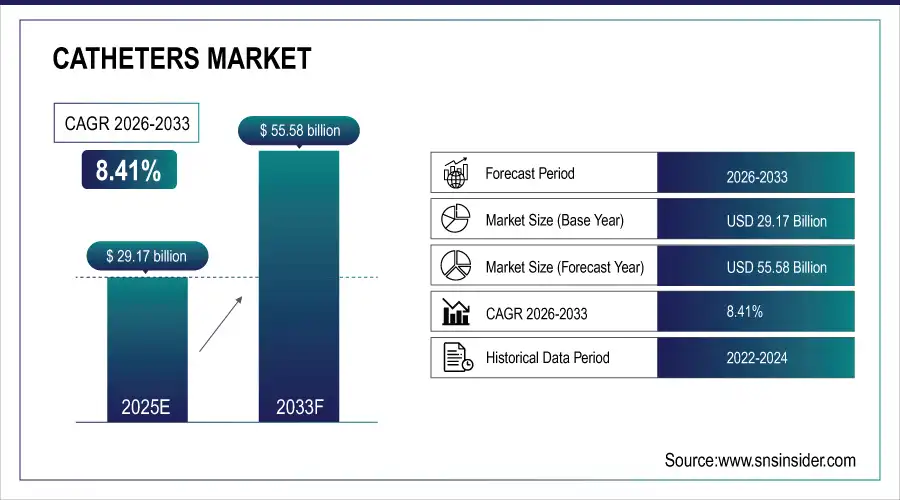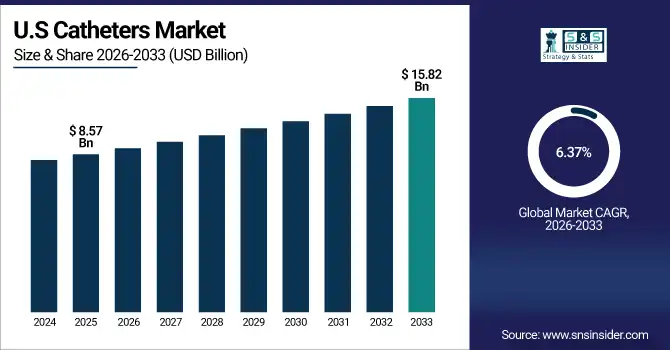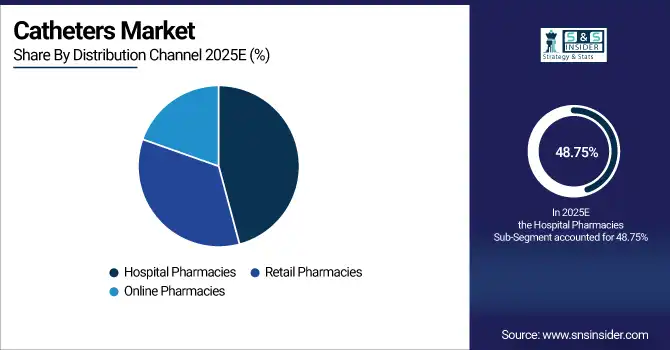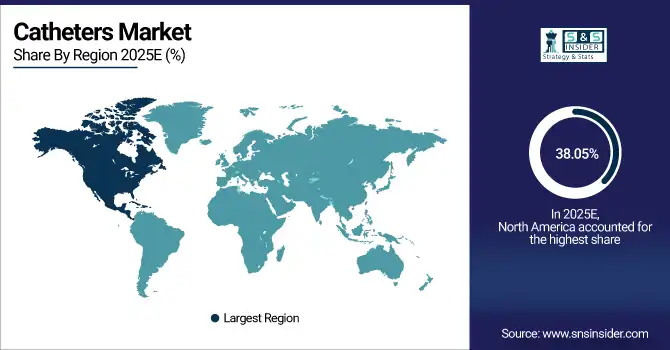Catheters Market Report Scope & Overview:
The global catheters market size was valued at USD 29.17 billion in 2025E and is projected to reach USD 55.58 billion by 2033, growing at a CAGR of 8.41% during the forecast period 2026–2033.
The global catheters market is growing steadily, fueled by over 100 million annual catheterization procedures worldwide, with urological catheters alone used by more than 5 million patients suffering from chronic urinary retention. Growing burden of cardiovascular disorders with 18 million deaths recorded every year and high demand for minimally invasive techniques boost the market growth. Hospitals lead use, and expanding homecare utilization, advanced biocompatible materials and the development of specialty catheters are driving growth worldwide.
Over 60% of catheter usage is in cardiovascular and urological procedures, with disposable catheters accounting for nearly 75% of total sales.
Market Size and Forecast:
-
Market Size in 2025: USD 29.17 Billion
-
Market Size by 2033: USD 55.58 Billion
-
CAGR: 8.41% from 2026 to 2033
-
Base Year: 2025
-
Forecast Period: 2026–2033
-
Historical Data: 2022–2024

To Get more information On Catheters Market - Request Free Sample Report
Catheters Market Trends:
-
Urological catheters will continue to lead, and account for over 40% of overall catheter demand in 2027, supported by surge in incidences of urinary incontinence and chronic retention.
-
Single use disposable catheters are expected to increase by just under 32% between 2026 and 2028 when disposables are likely to overtake reusable ones in importance as a result of infection control.
-
There were over 150 active clinical trials by 2025 investigating advanced coating technologies and antimicrobial catheter design.
-
Homecare scene is subsequently projected to experience 30% rise in catheter usage up to 2028, courtesy of aging populations and evolution of the outpatient care.
-
Tremendous innovation activity with next generation specialty catheters forecasted to be launched by over 50% of the leading Medtech companies worldwide by 2029.
U.S. Catheters Insights:
The U.S. leads the North American catheters market, valued at USD 8.57 billion in 2025E and projected to reach USD 15.82 billion by 2033, expanding at a CAGR of 6.37%. The country records more than 7 million catheter-based cardiovascular procedures every year, ensuring strong demand. Strong FDA clearance pipelines, preferential reimbursement systems and the location of leading Medtech innovators all make the U.S. the main hub for catheter innovation and clinical adoption.

Catheters Market Growth Drivers:
-
Rising Prevalence of Cardiovascular and Urological Disorders Fuels Global Demand for Advanced Catheterization Procedures.
The rising prevalence of cardiovascular and urological disorders is a key driver for catheter adoption. Worldwide, over 100 million catheterization procedures are undertaken annually, of which cardiovascular catheterizations represent almost 40 million. Urological requirements are also increasing and the number of long-term urinary catheter patients globally exceeds 5 million people. Hospitals are initial points of use while homecare catheter demand increases a further 25% with elderly patient diagnosis, spurring ongoing growth worldwide.
In 2025, nearly 65% of global catheter usage was concentrated in cardiovascular and urological procedures, establishing them as the leading clinical applications driving adoption.
Catheters Market Restraints:
-
Catheter-Associated Infections and Rising Antibiotic Resistance Limit Adoption, Creating Significant Challenges for Global Market Expansion.
Catheter-associated infections remain a major restraint, with nearly 250,000 cases reported annually in the U.S., and catheter-associated urinary tract infections (CAUTIs) representing up to 40% of all hospital-acquired infections. Worldwide, millions of patients are threatened yearly; infection-induced complications largely worsen hospital periods and therapy troubles. Increasing antimicrobial resistance restricts successful management, so prevention of infection is essential. These issues affect the rates of long-term catheter usage and consequently limit the universal application in hospitals, specialized clinics and homecare.
Catheters Market Opportunities:
-
Advancements in Antimicrobial Coatings and Biocompatible Materials Create Opportunities, Enhancing Safety and Expanding Catheter Adoption Worldwide.
Advancements in antimicrobial coatings and biocompatible materials are opening significant opportunities in the catheters market. More than 250,000 catheter-related falls per year are reported in the U.S., underscoring the criticality of safer designs. Hydrophilic or silver coated next-generation catheters can reduce the incidence of infections up to 40%, with silicon and polyurethane options for increased durability and patient comfort. These advancements are driving uptake in hospitals, specialty clinics and more recently homecare markets globally.
Over 70% of providers prefer antimicrobial-coated catheters, reducing infection risks and driving innovation-led adoption globally.
Catheters Market Segmentation Analysis:
-
By Product Type, Cardiovascular Catheters is the largest segment with a market share of 38.25% in 2025E, while Urological Catheters is the fastest-growing at a CAGR of 8.65%.
-
By Material, PVC Catheters is the largest contributor in 2025E with a share of 34.10% and Silicone Catheters grows at fastes CAGR of 8.89%.
-
By Application, Cardiovascular Procedures is the largest segment with 39.50% in 2025E, and Urology Procedures grows the fastest at CAGR of 8.74%.
-
By End User, Hospitals account for the largest share of 55.30% in 2025E and Homecare Settings is expected to grow at the fastest CAGR of 9.12%.
-
By Distribution Channel, Hospital Pharmacies lead with a 48.75% share in 2025E and Online Pharmacies is the fastest growing segment at CAGR 9.34%.
By Product Type, Cardiovascular Catheters Dominate While Urological Catheters Grow Rapidly:
Cardiovascular catheters dominate the market, supported by more than 40 million annual cardiovascular catheterization procedures globally, including angiography and angioplasty. Their vital role in diagnosing and treating heart disease secures steady demand. Urological catheters are expanding the fastest, with over 5 million chronic urinary retention patients depending on long-term catheterization worldwide. Rising elderly populations and increasing cases of urinary incontinence are fueling rapid adoption, especially in homecare and outpatient care settings.
By Material, PVC Catheters Dominate While Silicone Catheters Expand the Fastest:
PVC catheters are still the leading, cost-effective PVC and hospital usage is common in short-term procedures. They are cost-efficient with high patient throughput. But the fastest growing type is the silicone catheters, read for better biocompatibility and lower risk of irritation. It is demonstrated silicone constructions may reduce infectious complications by as much as 30% versus PVC, and are becoming the material of choice for long-term use among the elderly and immune compromised patient populations around the world.
By Application, Cardiovascular Procedures Lead While Urology Procedures Witness Strongest Growth:
Cardiovascular is driving catheter utilization in conjunction with the global burden of heart disease, accounting for 18 million deaths each year. Catheters are as well required for coronary intervention, electrophysiology and structural heart. Urology operations are the most rapidly increasing in demand, performing on over 400 million cases of worldwide urinary incontinence. The increasing awareness, geriatric population growth, and preference for minimally invasive treatment options are expected to drive catheterization, especially with the help of indwelling and intermittent urinary catheters in hospitals as well as home care.
By End User, Hospitals Lead While Homecare Settings Grow the Fastest:
The majority user is still hospitals, delivering millions of catheter-based therapies every year through high tech sites and practitioners. They rule because of their leadership in acute and emergency care. Homecare settings, on the other hand, are expanding most rapidly over 60% of long-term urinary catheter users worldwide opt for home-based care. Increased focus on outpatient care, the search for cost savings, and patient comfort is spurring a huge increase in home catheter use.
By Distribution Channel, Hospital Pharmacies Dominate While Online Pharmacies Rise Fastest:
Distribution is heavily by hospital pharmacies because most catheter-based procedures occur within inpatient settings, and devices are sold directly to healthcare providers. Yes, their track records and networks guarantee them a very solid footing. Online pharmacies are growing the fastest, driven by digital uptake and patient preference for confidential purchasing. Research suggests over 35% of long-term catheter users in Western markets will move to the online channel by 2028 due to convenience and increased availability for recurring catheter supply.

Catheters Market Regional Analysis:
North America Catheters Market Insights:
North America dominates the catheters market with a 38.05% share in 2025E, driven by high adoption of catheter-based diagnostics and interventions. In the U.S. alone, over 7 million cardiovascular catheterization procedures are done on an annual basis, contributing to its dominance. Increasing prevalence of urinary disorders, 30 million plus adults suffer from incontinence also fuels the demand for urological catheter. Solid FDA approvals, good reimbursement structures and rapid uptake of novel catheter technology make this the leading market for innovation and adoption, globally.

Get Customized Report as per Your Business Requirement - Enquiry Now
U.S. Catheters Market Insights:
The U.S. catheters market benefits from over 1,500 active clinical studies in 2025, driving innovation across cardiovascular, urinary, and neurovascular applications. Advanced catheters are used in over 70% of tertiary hospitals for improved accuracy. Strong FDA pipelines and AI-integrated imaging enhance procedural safety, which has the U.S. taking its place as global catheter innovation and adoption leader.
Asia-Pacific Catheters Market Insights:
The Asia-Pacific catheters market is projected to grow at a CAGR of 9.23%, making it the fastest growing region globally. Growth in demand is driven by over 12 million cardiovascular catheterization procedures performed a year in China, India and Japan. Growth is driven by the proliferation of catheterization labs, rising prevalence of urinary disorders, and robust rise in medical tourism with over 6 million inbound patients visiting India each year. In fact, over 65% of top hospitals use advanced catheter technology today.
China Catheters Market Insights:
China dominates the Asia-Pacific catheters market, performing over 5 million cardiovascular catheterization procedures annually, the highest in the region. Healthy support of government in healthcare sector and increasing prevalence of urinary disorders facilitates the adoption. China is shifting to becoming the regional focal point for innovation, clinical application and technology development with over 400 advanced catheterization centers.
Europe Catheters Market Insights:
Europe represents a vital hub in the global catheters market, supported by over 9 million catheter-based interventions annually across Germany, France, the UK, and Italy. The region was home to over 2,100 active clinical trials related to cardiovascular and urology catheters in 2025, driving innovation. Access remains high with more than 90% of patients insured under numerous public healthcare schemes. Considerable cardiovascular and urinary research budget support by the EU also underlines that Europe is ahead in applying advanced catheters.
Germany Catheters Market Insights:
Germany dominates the European catheters market, performing more than 2.5 million catheter-based procedures annually across over 200 advanced cardiac and urological centers. Robust reimbursement models, early penetration of minimally invasive procedures and significant participation in clinical studies all ensure that Germany remains at the forefront. All of this places the country as catheter innovator and adopter champion in the region.
Latin America Catheters Market Insights:
Latin America’s catheters market is growing steadily, supported by over 2.2 million catheter-based procedures annually across Brazil, Mexico, and Argentina. In Brazil, there are more than 80 specialised cardiac and urological centres conducting high volume catheter-based procedures. Increasing healthcare expenditure, better training of physician along with greater access to minimally invasive technologies will continue to drive uptake and revenue growth throughout the region.
Middle East and Africa Catheters Market Insights:
The Middle East and Africa catheters market is expanding, and more than 600 Cath labs in the region are to be operational by the year 2025, across Saudi Arabia, UAE and South Africa. The rise in government supported investment in advanced cardiovascular and urology technologies and upsurge of inbound medical tourism (of close to 1.2 million patients per year) are stimulating uptake, shape the region for continual long-term success.
Transcatheter Catheters Competitive Landscape:
Medtronic dominates the global catheters market, with its portfolio used in over 10 million patient procedures every year. The company is driving innovation in over 300 active catheter-based clinical studies for cardiovascular, neurovascular and renal applications. Medtronic is present in over 150 countries and combines scale and R&D capabilities. with its wide array of products and continued advancement in device creation to be the world’s leading provider of catheter-based components for use in various therapeutic areas.
-
In March 2025, Edwards Lifesciences received CE Mark approval for its SAPIEN M3 system, the first transfemoral transcatheter mitral valve replacement therapy for patients unsuitable for surgery or repair.
Boston Scientific is a top innovator in catheter technologies, with products adopted in more than 7 million annual procedures worldwide. It fuels development with more than 250 active clinical programs concentrating on leading cardiovascular and electrophysiology catheter solutions. Boston Scientific operates in over 130 countries and focuses on Physician Partnerships with minimally Invasive care, safety and efficacy. Its worldwide impact in the clinic ensures that your catheter innovation and adoption move forward with a trusted leader.
-
In June 2025, Medtronic advanced its APOLLO trial evaluating the Intrepid TMVR device, enrolling over 2,500 patients with severe symptomatic mitral regurgitation.
B. Braun is a key global player, producing over 2 billion catheters annually across vascular access, infusion, and urology. Operating in over 120 countries, the company offers one of the widest portfolios of products. Its 64 dedicated production facilities worldwide guarantee an uninterrupted supply. Guided by our commitment to patient safety and infection prevention, sustainability, B. Braun has become a world leading catheter supplier serving some of the world’s largest OEM companies.
-
In September 2025, Abbott gained FDA approval for its Tendyne TMVR system, offering a breakthrough replacement option for patients with severe mitral annular calcification.
Catheters Market Key Players:
Some of the Catheters Market Companies are:
-
Medtronic plc
-
Boston Scientific Corporation
-
B. Braun Melsungen AG
-
Becton, Dickinson & Company
-
Coloplast A/S
-
Edwards Lifesciences Corporation
-
Teleflex Incorporated
-
Johnson & Johnson Services, Inc.
-
Terumo Corporation
-
Abbott Laboratories
-
Cook Medical
-
Hollister Incorporated
-
Merit Medical Systems
-
Cardinal Health
-
AngioDynamics
-
Smiths Medical, Inc.
-
ConvaTec Group PLC
-
BIOTRONIK SE & Co. KG
-
Penumbra, Inc.
-
Amsino International
| Report Attributes | Details |
|---|---|
| Market Size in 2025 | USD 29.17 Billion |
| Market Size by 2033 | USD 55.58 Billion |
| CAGR | CAGR of 8.41% From 2026 to 2033 |
| Base Year | 2025 |
| Forecast Period | 2026-2033 |
| Historical Data | 2022-2024 |
| Report Scope & Coverage | Market Size, Segments Analysis, Competitive Landscape, Regional Analysis, DROC & SWOT Analysis, Forecast Outlook |
| Key Segments | • By Product Type (Cardiovascular Catheters, Urological Catheters, Neurovascular Catheters, Specialty Catheters, Others) • By Material (PVC, Silicone, Polyurethane, Others) • By Application (Cardiovascular, Urology, Neurovascular, Gastroenterology, Others) • By End User (Hospitals, Ambulatory Surgical Centers, Specialty Clinics, Homecare Settings) • By Distribution Channel (Hospital Pharmacies, Retail Pharmacies, Online Pharmacies) |
| Regional Analysis/Coverage | Medtronic plc, Boston Scientific Corporation, B. Braun Melsungen AG, Becton, Dickinson & Company, Coloplast A/S, Edwards Lifesciences Corporation, Teleflex Incorporated, Johnson & Johnson Services, Inc., Terumo Corporation, Abbott Laboratories, Cook Medical, Hollister Incorporated, Merit Medical Systems, Cardinal Health, AngioDynamics, Smiths Medical, Inc., ConvaTec Group PLC, BIOTRONIK SE & Co. KG, Penumbra, Inc., Amsino International |
| Company Profiles | Edwards Lifesciences Corporation, Medtronic plc, Abbott Laboratories, Boston Scientific Corporation, LivaNova PLC, Neovasc Inc., JenaValve Technology, Inc., Micro Interventional Devices, Inc., Cardiac Dimensions, Inc., HighLife SAS, Valtech Cardio Ltd., Tendyne Holdings, Inc., Mitralign, Inc., 4C Medical Technologies, Inc., Cephea Valve Technologies, Inc., MValve Technologies Ltd., Transcatheter Technologies GmbH, Ancora Heart, Inc., Navigate Cardiac Structures, Inc., CryoLife, Inc. |

